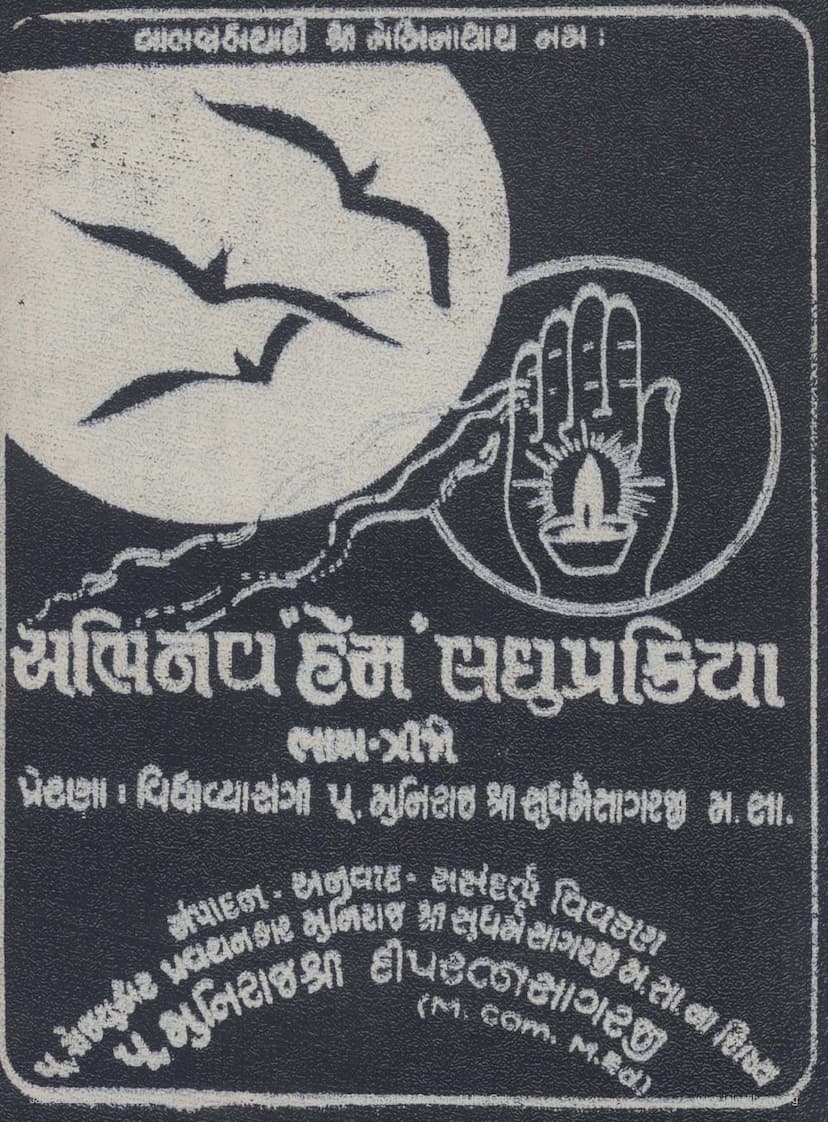Abhinav Hem Laghu Prakriya Part 03
Added to library: September 1, 2025

Summary
The provided Jain text, "Abhinav Hem Laghu Prakriya Part 03" by Dipratnasagar and Deepratnasagar, published by Abhinav Shrut Prakashan, is a detailed commentary and translation into Gujarati of the "Hem Laghu Prakriya," a Jain grammatical text. This particular volume, part 3, focuses on the verbs (Aakhyat), specifically the "Parasmaipad" forms.
Here's a breakdown of the content based on the provided pages:
Core Content:
- Focus on Verbs (Aakhyat): The text delves into the study of verbs in Sanskrit grammar, particularly within the framework of the Hemchandracharya's "Siddhahem Shabdanushasan." It aims to provide a comprehensive understanding of verb conjugations.
- Ten Verb Classes (Dasha Gana): The book systematically explains the eight, and practically ten, verb classes (Gana) as described in Jain grammatical tradition. The text mentions that while Hemchandracharya listed nine ganas, ten are prevalent in practice and are presented here.
- Ten Tenses (Dasha Kal): It covers the ten tenses of Sanskrit verbs: Vartamana (present), Saptami Vidhyarth (optative), Panchami Ajnarth (imperative), Hyastani (imperfect), Adyatani Paroksha (perfect), Paroksha (aorist), Ashi (benedictive), Shvashtani (future), Bhavishanti (future), and Kriyatipatti (periphrastic past).
- Detailed Analysis: For each verb root (Dhatu), the text provides:
- The root itself.
- Its meaning.
- Its class (Gana).
- The specific rules (Sutra) governing its conjugation.
- The commentary (Vritti) explaining the rules.
- The translation (Anuvad) of the commentary into Gujarati.
- The specific application of the rules to form various verb forms.
- Special sections explaining particular grammatical nuances, exceptions, or important points related to the verb.
- Cross-references to other related sutras or texts.
- Examples and Elaboration: The text extensively uses examples to illustrate the conjugation of verbs, making the grammatical rules understandable. It breaks down the formation of verb forms step-by-step.
- Reference to Bṛhad-vṛtti and Nyāya-saṅgraha: The introduction highlights that this translation includes appropriate citations and explanations drawn from larger grammatical works like the "Bṛhad-vṛtti" and "Nyāya-saṅgraha," which are often not readily accessible to students of the Laghu-vṛtti.
- Language and Purpose: The translation is presented in simple and clear Gujarati, aiming to facilitate the study and teaching of the Laghu Prakriya and, by extension, the "Siddhahem Shabdanushasan" itself.
Key Individuals and Contributions:
- Pujya Gurudev Shri Sudharmasagarji Maharaj Saheb: Is repeatedly credited as the inspiration, guiding force, and source of strong conviction behind the writing and publication of this work. His "utkat lagi - bhavna" (intense feeling-emotion) and dedication are cited as making the project possible.
- Pujya Muni Shri Deepratnasagarji (M.Com., M.Ed.): Is acknowledged as the disciple who undertook the meticulous task of editing, translating, and providing commentary for the third part of this series.
- Pujya Mahopadhyaya Vinayavijayji Ganivar: Is recognized as the author of the "Hem Laghu Prakriya," which this work is based upon and aims to make more accessible.
- Publisher: Abhinav Shrut Prakashan: Undertook the publication, with Praveenbhai J. Mehta being a key figure.
- Printers: Jay Kalyan Prints, Jamnagar: The printing was done by this establishment.
- Other Contributors: Various individuals and Jain sanghs (communities), including the Jamnagar Jain Sangh, are thanked for their support and financial contributions, particularly for the paper used in the book.
Structure and Presentation:
- Introduction (Prastavana): Explains the importance of studying grammar, the significance of this "Abhinav Hem Laghu Prakriya," how to use the book, and acknowledges the contributions of various individuals.
- Table of Contents (Vishay Suchi): Lists the various verb classes (Gana), suffixes (Pratyaya), appendices (Parishisht), and indices (Anukramanika).
- Appendices: Include an alphabetical index of sutras (Akaradi Sutra Kram), the Siddhahem sutra sequence (Siddhahem Sutra Kram), errata (Shuddhipatraka), verb form tables (Dhaturupavali-Dha-ri-prakriya), a reference list (Sandarbh Suchi), and a list of donors (Dullay Sahayake!-Namavali).
- Detailed Verb Analysis: The bulk of the book is dedicated to the systematic explanation of verb roots, their classes, tenses, and the formation of various verb forms through detailed grammatical analysis.
Overall Purpose:
The "Abhinav Hem Laghu Prakriya Part 03" serves as a bridge between the complex original Sanskrit grammatical texts and the Gujarati-speaking audience, particularly those within the Jain tradition. It aims to demystify the intricate rules of Sanskrit verb conjugation, making the profound knowledge of the "Siddhahem Shabdanushasan" accessible and promoting a deeper understanding of Jain scriptures. The emphasis is on reaching eternal happiness (eternal Sukha) through the contemplation and understanding of the sacred texts.